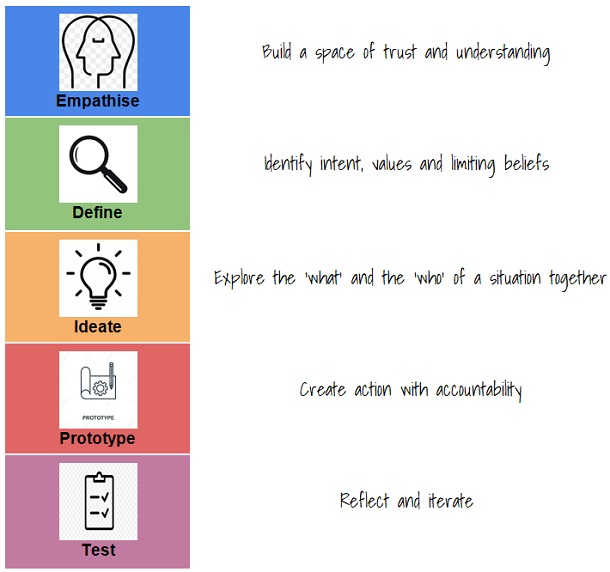A Coaching Model By Jonathon Regan, Transformation in Education Coach, NETHERLANDS
A Design Thinking Approach to Coaching: Solutions-Building, Not Just Problem-Solving.
Motivation
Like you, I am a life-long learner and leader. I am passionate about the legacy of education and the impact that our decisions as leaders have on the futures of the people in our schools. How do we ensure that the decisions we make are the right ones? That surely is a wicked problem! I believe that a design thinking approach is necessary – one that leads with relationships born of trust and empathy. Acting merely as a consultant is not good enough for a world of wicked problems. You need a bold coach.
Philosophy
The design thinking process takes any problem and breaks it down into manageable chunks: Empathise; Define; Ideate; Prototype; Test. It is a creative and collaborative process that puts the needs of the client first. Just like pure coaching, it is a process driven by questions and observations. It is a tool for innovation.
I first used design thinking with my students in the classroom and found that its processes built deep learning by connecting disciplines and ideas. I have leaned on the tenets of design for over 20 years, developing technology strategy, instructional design, curriculum, and wider school policy. The decision to be more deliberate in blending a design thinking approach with coaching has allowed me to better meet the needs of all my clients, irrespective of age, roll, status or experience.
And so here is the bold vision behind this model – For lifelong learners and leaders to have access to a professional listener, to mediate those conversations that lead to decisions and provide sustainable action and lasting growth.
As a bold coach my mission is – To provide a space of trust for lifelong learners and leaders to explore thoughts and ideas that will result in sustainable systemic action, forward momentum and well being for themselves and their communities.
How does it work?

With a bold coach at your side, you will clear a path for action. On the road, you will discover the silver linings that lay hidden behind disruption, change and challenge to move forward with clarity, confidence and certainty. Coaching conversations keep you and your organisation healthy.
You will:
- Develop a design thinking approach to strategy.
- Nurture an environment of optimistic prototyping.
- Build resilience against future disruption.
An example: technology transition in schools.
The 4th industrial revolution has given us tools that provide incredible capabilities for insight, but at the same time has thrown up a fog so dense, we have little idea of what our futures look like. It is a time of disruption.
One thing we can be certain of is that for our young people, a predictable career path that follows a single linear trajectory is a thing of the past. The skills that they will need to navigate this opaque new world are under debate, but they will absolutely include the ability to commune in a digitally rich environment.
Students, teachers, parents, leaders, accreditation organisations, supervisory boards, national governmental departments and international bodies – With so many perspectives to consider, the challenge of developing school strategies around technology that provide the best value to all stake-holders will always be daunting and time consuming.
Yet every now and again we are handed opportunities to take huge leaps forward. Take the pandemic that started in 2020 which left 1.6 billion students and 60 million teachers unable to attend their classes. As a result, schools leveraged technology to adopt a variety of digital distance-learning solutions. Students and teachers adapted, and learning continued in new ways.
The adage “Never let a good crisis go to waste” comes to mind. It is characterised by challenge, resilience, adaptability, reflection, ultimately leading to a new and enhanced condition. It implies that those who have endured crises may have been gifted an opportunity to thrive.
May have been. The innate human tendency after disruption is to get back to normal as quickly as possible. In order not to waste the opportunity and slip backwards to normal, the silver linings of crisis need to be identified and frameworks for leveraging the learnings must be established and adopted.
Enter, your bold coach…
Feature – A bold coach is a professional listener who will guide conversations around challenges, and create empathy in a space of trust for groups and individuals.
Your coach will facilitate the discovery of skills, values and talents that are the foundation of current success. Using powerful questioning with decision and planning tools, they will help you build a narrative for your journey, and clear a path for action.
Advantage – By focusing on strengths not deficits, you will discover the silver linings that lay hidden in this disruption. As an agile model, the emphasis is shifted from finding a single limiting solution, to the exploration of multiple opportunities that stay true to your mission. By retaining control over the small bets you invest in, you will not become overwhelmed by big decisions that can take on a life of their own.
This model uses both divergent and convergent thinking. The process can be fun, which builds community and takes the sting out of change.
Benefit – The creation of bold, robust and agile strategies that inspire others and build resilience in the face of future challenge or disruption; The setting of goals that increase accountability and improve team cohesiveness; Lower staff turnover with improved job satisfaction and enjoyment; Healthier leaders making healthier decisions with their communities.
What mattered most before Pandemic? What matters most now? Does your vision reflect that? Are your approaches to fulfilling that vision as robust as they can be?
What will you do in the face of the next crisis – Will you dust down the responses to the last one, or look to your new framework for solutions building?
Don’t delay - Make bold decisions, optimised for wellbeing and sustainability.